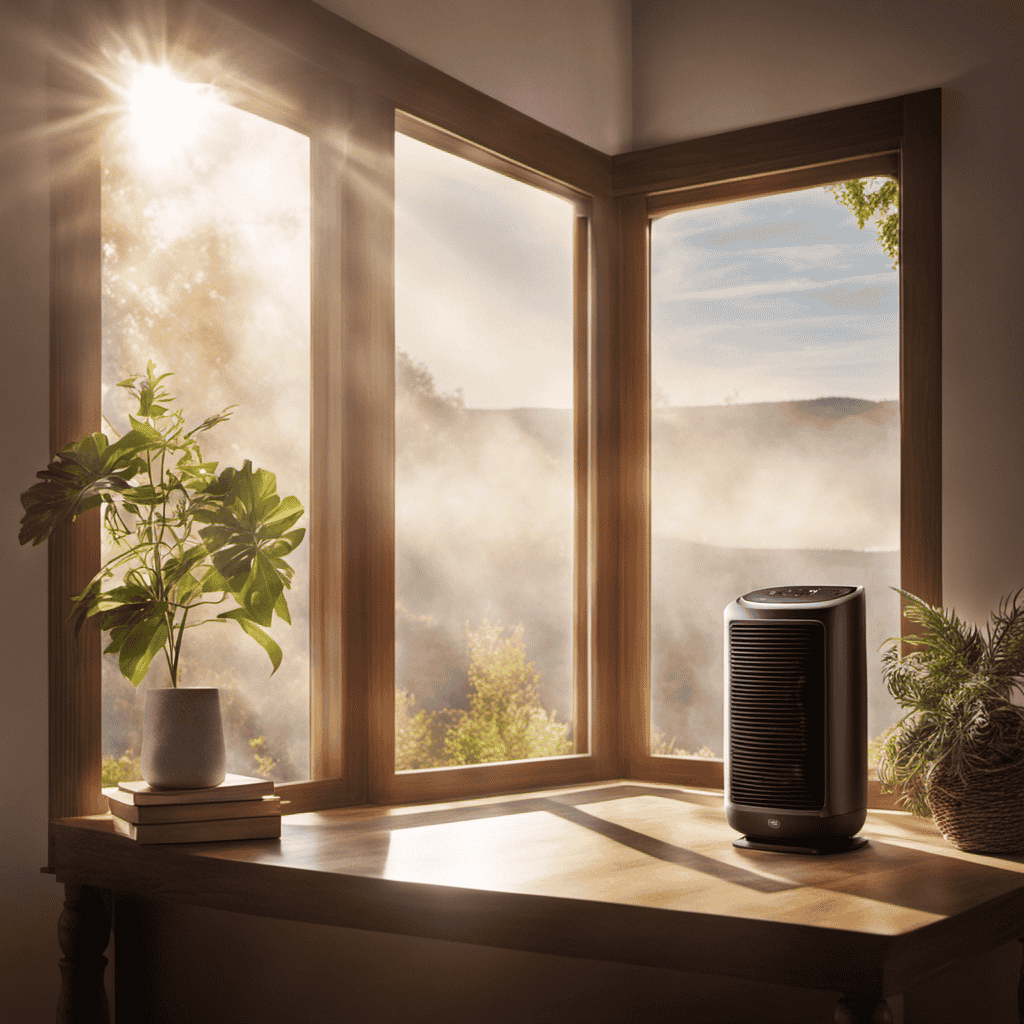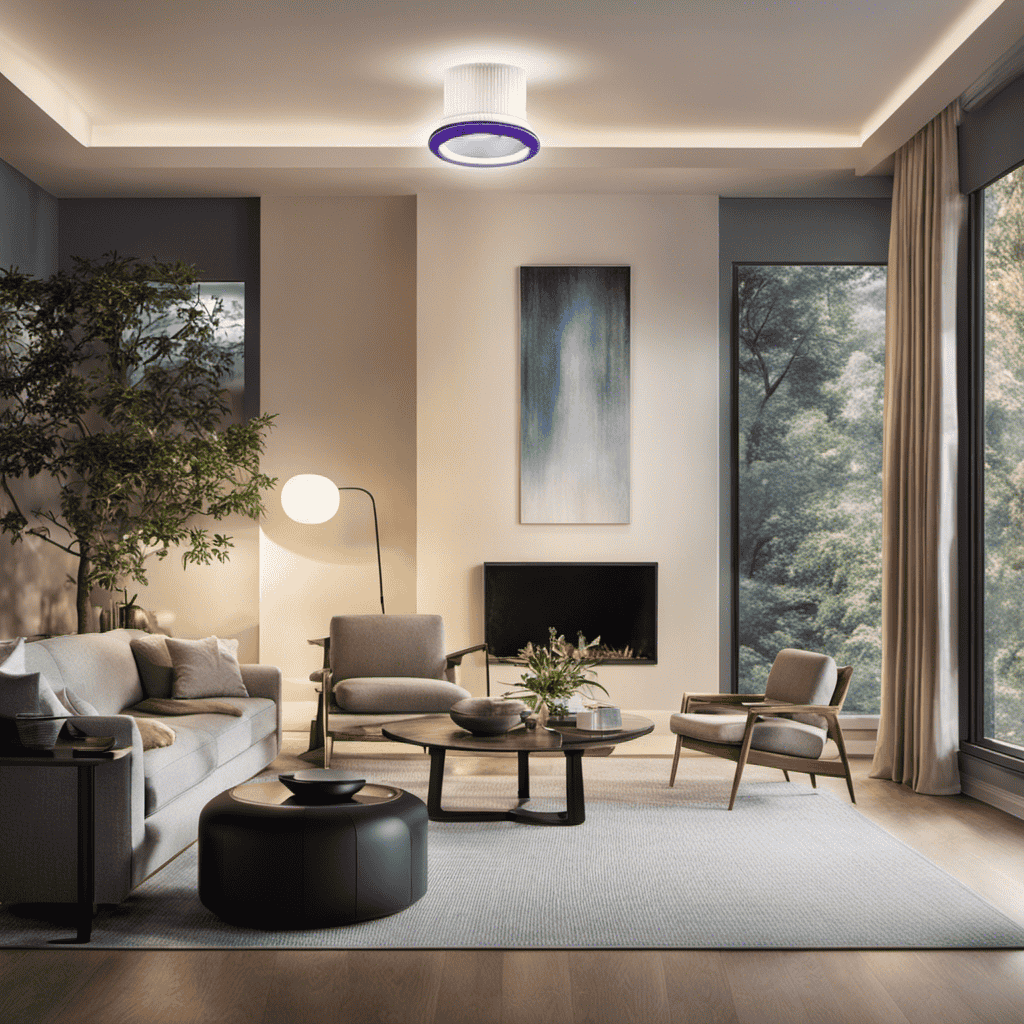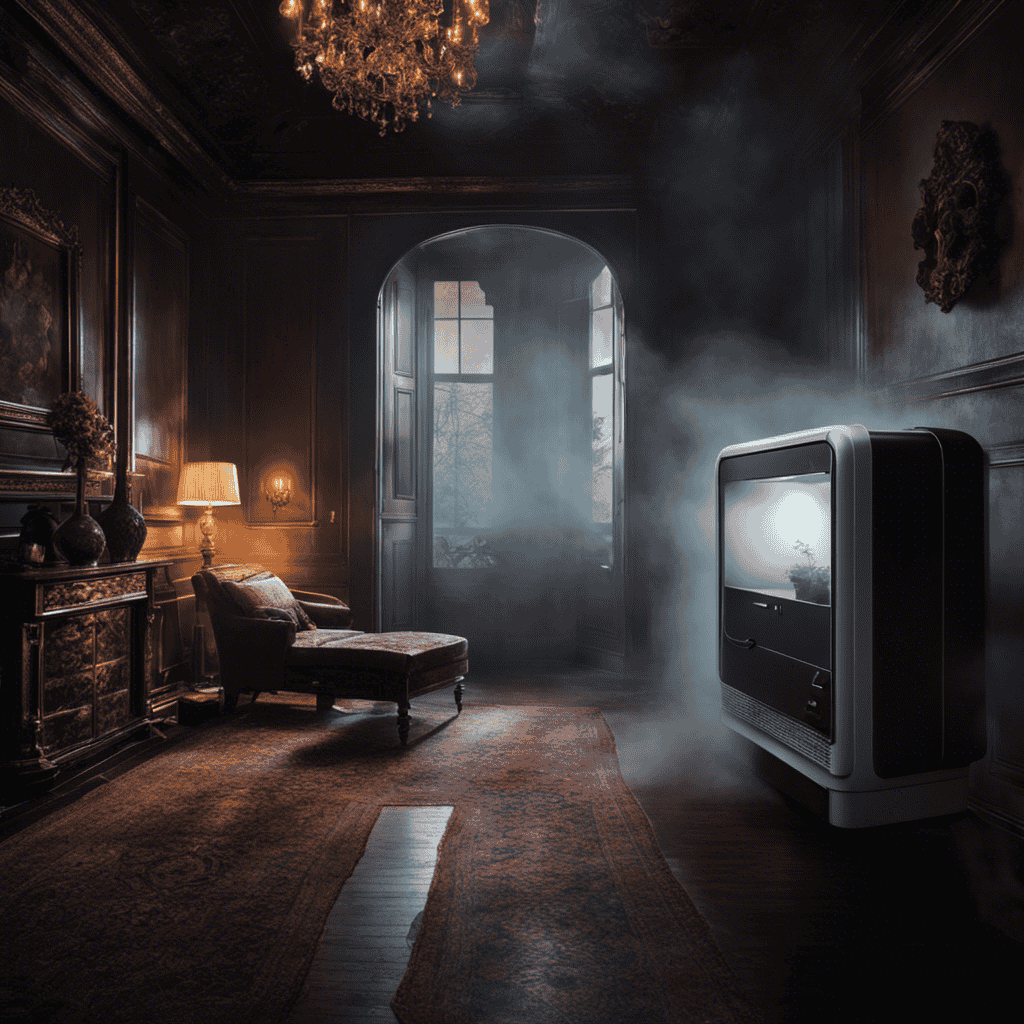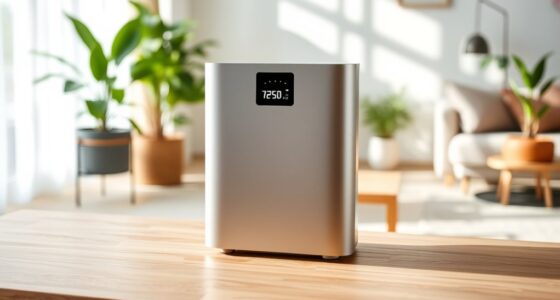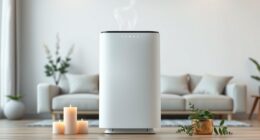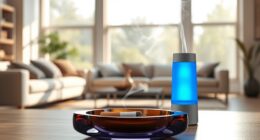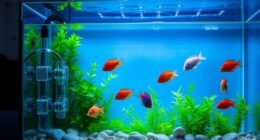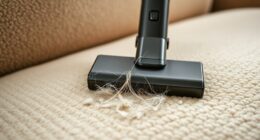I regularly clean my air purifier to ensure that I am breathing in fresh and clean air. It is important to keep your air purifier clean for it to work efficiently and effectively in removing pollutants from the air.
In this article, I will provide you with a comprehensive guide on how often you should clean your air purifier, the signs that indicate it needs cleaning, and the step-by-step process to properly clean it.
Let’s dive into the world of air purifier maintenance and discover the best practices for a healthier environment.
Key Takeaways
- Regular maintenance and cleaning are crucial for optimal performance of an air purifier.
- Cleaning frequency should be based on the manufacturer’s instructions and the level of air pollution.
- Signs that your air purifier needs cleaning include foul odor, reduced air circulation, and excessive dust accumulation.
- Cleaning techniques include wiping down the exterior, cleaning filters as recommended, and avoiding harsh chemicals or abrasive materials.
Importance of Regular Air Purifier Maintenance
Regular air purifier maintenance is crucial for ensuring clean and healthy indoor air. As a scientist, I have extensively researched the best cleaning methods and cleaning frequency recommendations for air purifiers.
It is recommended to clean the air purifier at least once every three to six months, depending on the manufacturer’s instructions and the level of air pollution in your environment. The cleaning process involves removing the filters and gently vacuuming or rinsing them to remove trapped particles and pollutants. Additionally, wiping down the exterior of the air purifier with a damp cloth helps remove dust and dirt.
Factors That Determine Cleaning Frequency
The frequency of cleaning your air purifier depends on various factors, such as how dirty the environment is and how frequently you use it. Cleaning your air purifier regularly is essential to ensure its optimum performance and longevity. Below is a table that showcases the factors that determine the cleaning frequency of your air purifier.
| Factors to Consider | Cleaning Frequency |
|---|---|
| Environmental Dirt | High |
| Frequency of Use | High |
| Filter Type | Varies |
| Indoor Pollution | High |
| Allergen Exposure | High |
To maintain a clean and efficient air purifier, it is important to follow proper cleaning techniques. Start by turning off and unplugging the device. Remove the filters and gently clean them with a soft brush or vacuum cleaner. For more stubborn dirt, you can use mild soap and water. Allow the filters to dry completely before reinstalling them. Additionally, wipe down the exterior of the air purifier with a damp cloth to remove any dust or residue. By following these cleaning techniques and considering the factors mentioned above, you can ensure a healthy and clean environment in your home or office.
Signs That Your Air Purifier Needs Cleaning
As an air quality expert, I have come across several key points that indicate when an air purifier needs cleaning.
Firstly, a foul odor emanating from the purifier is a clear sign that it requires cleaning. This odor can be caused by the accumulation of bacteria, mold, or other pollutants that have been trapped in the filter.
Secondly, if you notice reduced air circulation or a decrease in the purifier’s effectiveness, it’s time for a thorough cleaning. Dust and debris can obstruct the airflow, leading to poor performance.
Lastly, excessive dust accumulation on the surface of the purifier or in the filter indicates that it needs cleaning. Regular maintenance and cleaning are crucial to ensure the optimal functioning of your air purifier and to maintain clean and healthy indoor air quality.
Foul Odor Indicates Cleaning
If you notice a foul odor, it’s time to clean the air purifier. Foul odors can indicate a buildup of contaminants and particles in the filters of the air purifier, which can reduce its effectiveness in removing pollutants from the air.
To troubleshoot foul odors and ensure the air purifier is working efficiently, consider the following steps:
- Remove and inspect the filters. Clean or replace them as needed.
- Check for mold or mildew growth. Use alternative cleaning methods, such as vinegar or hydrogen peroxide, to kill any bacteria or fungi.
- Clean the air purifier’s exterior and vents using a damp cloth and mild detergent.
Regular maintenance and cleaning of the air purifier will not only eliminate foul odors but also prolong its lifespan and improve indoor air quality.
Reduced Air Circulation Signals Cleaning
When you notice reduced air circulation, it’s time to check for any obstructions in the vents or filters.
Factors affecting cleaning frequency include the level of pollutants in the air, the size of the room, and the type of air purifier being used.
For instance, if you live in a highly polluted area or have pets, you may need to clean your air purifier more frequently. Additionally, larger rooms may require more frequent cleaning to maintain optimal air quality.
It is important to avoid common cleaning mistakes such as neglecting to clean the filters regularly or using improper cleaning techniques. Cleaning with harsh chemicals can damage the filters and reduce their effectiveness.
Regular maintenance and proper cleaning techniques are essential to ensure that your air purifier continues to provide clean and fresh air.
Excessive Dust Accumulation Signifies Cleaning
Excessive dust accumulation may indicate the need for cleaning, particularly if you live in a dusty environment or have pets. Cleaning your air purifier regularly is crucial to maintain its effectiveness and ensure clean indoor air.
Here are some air purifier maintenance tips and the benefits of cleaning it regularly:
-
Remove and clean the pre-filter: The pre-filter captures larger particles, preventing them from clogging the main filter.
-
Clean or replace the main filter: Over time, the filter gets filled with dust, allergens, and pollutants, reducing its efficiency. Regular cleaning or replacement is necessary to maintain optimal performance.
-
Clean the exterior and vents: Dust and debris can accumulate on the exterior and vents, hindering airflow. Regular cleaning ensures proper air circulation and prevents dust buildup on surfaces.
Regularly cleaning your air purifier improves its longevity, enhances air quality, and reduces the risk of respiratory issues caused by indoor air pollutants. Make it a part of your routine to enjoy clean and healthy indoor air.
Step-by-Step Guide to Cleaning Your Air Purifier
When it comes to cleaning your air purifier, it’s important to follow the recommended frequency guidelines to ensure optimal performance. Regular cleaning not only prolongs the lifespan of your purifier but also ensures that it continues to effectively remove pollutants from the air.
In this discussion, we will explore the cleaning frequency recommendations and the best methods to clean your air purifier based on scientific evidence.
Cleaning Frequency Recommendations
The recommended cleaning frequency for an air purifier depends on factors such as the manufacturer’s instructions and the level of air pollution in your area. To determine how often you should clean your air purifier, consider the following factors:
-
Manufacturer’s Instructions:
-
Read the user manual provided by the manufacturer to understand their specific recommendations for cleaning and maintenance.
-
Some manufacturers may suggest cleaning the filters every few months, while others may recommend a more frequent cleaning schedule.
-
Level of Air Pollution:
-
If you live in an area with high air pollution, such as near industrial areas or busy roads, you may need to clean your air purifier more frequently.
-
Pollutants can accumulate on the filters faster in these areas, reducing the efficiency of the air purifier.
-
Tips for Extending Air Purifier Lifespan:
-
Regularly vacuum the exterior and vents of the air purifier to remove dust and debris that can hinder its performance.
-
Replace or clean the filters as recommended by the manufacturer to maintain optimal air purification.
Best Cleaning Methods?
Now that we know how often we should clean our air purifiers, let’s discuss the best cleaning methods.
Keeping our air purifiers clean is essential for maintaining their effectiveness in removing pollutants from the air. The first step is to consult the manufacturer’s instructions, as they often provide specific cleaning guidelines. In general, the best cleaning technique involves regularly wiping down the exterior of the unit with a damp cloth and cleaning the filters according to the manufacturer’s recommendations. It is important to avoid using harsh chemicals or abrasive materials that could damage the unit. Additionally, some air purifiers may have washable filters that can be rinsed and dried before reinstallation.
By following these best cleaning techniques and adhering to the recommended cleaning schedule, we can ensure that our air purifiers continue to function optimally in improving indoor air quality.
Now, let’s move on to the next section where we will discuss the recommended cleaning products for air purifiers.
Recommended Cleaning Products for Air Purifiers
To keep your air purifier in good condition, it is important to use recommended cleaning products. Proper cleaning techniques are essential for maintaining the performance and longevity of your air purifier. Here are some eco-friendly cleaning options to consider:
-
Vinegar solution: Create a gentle yet effective cleaning solution by mixing equal parts of white vinegar and water. Vinegar has antimicrobial properties that can help eliminate bacteria and odors.
-
Baking soda: Absorb unpleasant smells by sprinkling baking soda on the pre-filter or activated carbon filter. Let it sit for a few hours before vacuuming or wiping it off.
-
Microfiber cloth: Wipe down the exterior of the air purifier using a microfiber cloth. Microfiber is gentle on surfaces and can effectively remove dust and dirt.
Using these eco-friendly cleaning options will ensure that your air purifier remains in top condition while minimizing the impact on the environment. Remember to consult your air purifier’s user manual for specific cleaning instructions.
Common Mistakes to Avoid When Cleaning Air Purifiers
When cleaning your air purifier, it’s important to avoid common mistakes that could affect its performance. There are several factors that can affect the frequency at which you should clean your air purifier, including the size of the room, the number of people in the room, and the presence of pets or smokers. However, regardless of these factors, there are some common cleaning mistakes that you should always avoid. These include using harsh chemicals, neglecting to clean the filters regularly, and not cleaning the exterior of the purifier. By avoiding these mistakes and following the manufacturer’s instructions, you can ensure that your air purifier continues to effectively remove pollutants from your indoor air.
| Common Cleaning Mistakes | How to Avoid |
|---|---|
| Using harsh chemicals | Stick to mild, non-toxic cleaners recommended by the manufacturer |
| Neglecting filter cleaning | Clean or replace filters as instructed by the manufacturer |
| Not cleaning the exterior | Wipe down the exterior regularly with a damp cloth |
Cleaning Tips for Different Types of Air Purifiers
Different types of air purifiers require specific cleaning methods to ensure optimal performance. When it comes to cleaning your air purifier, it’s important to follow the manufacturer’s instructions to avoid damaging the unit.
Here are some cleaning tips for different types of air purifiers:
-
For HEPA air purifiers:
-
Vacuum the pre-filter regularly to remove large particles.
-
Replace the HEPA filter as recommended, usually every 6-12 months.
-
Clean the exterior with a damp cloth to remove dust and dirt.
-
For activated carbon air purifiers:
-
Replace the carbon filter as recommended, usually every 3-6 months.
-
Wipe the exterior with a mild detergent to remove any residue.
-
For ionizer air purifiers:
-
Clean the ionizing wires or plates regularly to remove accumulated particles.
-
Wipe the exterior with a soft cloth to remove dust.
By following these cleaning techniques, you can ensure that your air purifier functions effectively in removing pollutants from the air. However, if you encounter any issues or have difficulty troubleshooting common problems, it’s best to consult the manufacturer’s guide or contact customer support for further assistance.
Now, let’s explore how often you should change air purifier filters to maintain its efficiency.
How Often to Change Air Purifier Filters
Make sure you follow the manufacturer’s recommendations on changing the filters of your air purifier to maintain its efficiency.
The lifespan of air purifier filters can vary depending on the type of filter and the level of pollutants in your environment. Generally, it is recommended to replace the filters every 3 to 6 months. However, some filters may need to be replaced more frequently, especially if you live in an area with poor air quality or if you have pets or allergies.
It’s important to note that air quality standards may also influence the frequency of filter changes.
Regularly changing the filters ensures that your air purifier continues to effectively remove pollutants from the air, helping to maintain clean and healthy indoor air.
When it comes to cleaning your air purifier, there are both pros and cons to professional cleaning and DIY cleaning, which I will discuss in the next section.
Professional Cleaning Vs. DIY Cleaning: Pros and Cons
When it comes to maintaining a clean and healthy living environment, there are two main options: professional cleaning and DIY cleaning.
Both approaches have their own pros and cons that need to be considered.
Professional cleaning offers the advantage of expertise and specialized equipment, but it can be costly and may not always be necessary for routine cleaning tasks.
On the other hand, DIY cleaning allows for greater flexibility and cost savings, but it requires time and effort to achieve the same level of cleanliness as professional services.
Ultimately, the choice between professional cleaning and DIY cleaning depends on individual preferences, budget, and the specific cleaning needs.
Pros and Cons of Professional Cleaning
Have you considered the pros and cons of having your air purifier professionally cleaned? Professional cleaning services for air purifiers offer several benefits, including:
- Thorough Cleaning: Professionals have the expertise and equipment to clean every nook and cranny of your air purifier, ensuring optimal performance and air quality.
- Extending Lifespan: Regular professional cleaning can help prolong the lifespan of your air purifier by preventing dust build-up and reducing strain on the system.
- Improved Efficiency: A clean air purifier operates more efficiently, saving energy and potentially reducing your utility bills.
However, it’s important to weigh these advantages against the cost effectiveness of professional cleaning services. While professional cleaning can be more expensive upfront, it may save you money in the long run by enhancing the durability and efficiency of your air purifier.
Transitioning into the subsequent section about the efficiency of DIY cleaning, let’s explore the benefits and drawbacks of taking matters into your own hands.
Efficiency of DIY Cleaning
There are various factors to consider when deciding whether to clean your air purifier yourself. One key factor is the efficiency improvement that can be achieved through DIY cleaning. By regularly maintaining and cleaning your air purifier, you can ensure that it is operating at its optimal level, effectively removing airborne pollutants from your indoor environment. Additionally, DIY cleaning methods can be cost effective, saving you money in the long run. To provide a deeper understanding of the efficiency improvement and cost effectiveness of DIY cleaning, I have created the following table:
| Efficiency Improvement | Cost Effective Cleaning Methods |
|---|---|
| Regular cleaning | Vacuuming the filter |
| Replacing filters | Wiping down the exterior |
| Cleaning the fan | Using compressed air |
| Checking for leaks | DIY cleaning solutions |
Maintaining a Clean Environment for Your Air Purifier
To keep your air purifier running smoothly, make sure you regularly clean the filters and replace them as needed. Cleaning techniques are essential for maintaining optimal performance and ensuring the air purifier effectively removes pollutants from the air.
Here are some key cleaning techniques to consider:
-
Vacuuming: Use a brush attachment to gently vacuum the surface of the filters to remove dust and debris.
-
Washing: Some filters can be washed with water and mild detergent. Follow the manufacturer’s instructions for proper cleaning.
-
Air-drying: After washing the filters, allow them to air-dry completely before reinstalling them in the air purifier.
Regular maintenance of your air purifier is crucial for optimal performance. By following these cleaning techniques, you can ensure that your air purifier functions efficiently and provides you with clean, fresh air.
What is the recommended frequency for cleaning an air purifier?
When it comes to cleaning Winix air purifier instructions, it’s important to follow the manufacturer’s recommendations. Generally, it is recommended to clean the pre-filter every 2-3 months and replace it every 12 months. The carbon filter should be replaced every 6 months, while the True HEPA filter should be replaced annually.
Frequently Asked Questions
Can I Use Any Cleaning Product to Clean My Air Purifier?
I can use any cleaning product to clean my air purifier, but it’s important to follow recommended cleaning techniques and frequency. Regular cleaning helps maintain optimal performance and ensures clean air in my home.
Can I Clean My Air Purifier With Water?
Yes, you can clean your air purifier with water. However, it is important to follow the manufacturer’s instructions and use the recommended cleaning methods to ensure proper maintenance.
How Long Does It Take to Clean an Air Purifier?
Cleaning an air purifier is crucial for its proper functioning. Regular maintenance is recommended, including cleaning the filters and other components. Best practices for air purifier cleaning ensure optimal performance and clean indoor air quality.
Do I Need to Turn off My Air Purifier While Cleaning It?
When cleaning my air purifier, I always turn it off to ensure safety and effectiveness. By doing so, I can clean all the components thoroughly and prevent any damage or accidents.
Can I Clean the Filters of My Air Purifier Without Replacing Them?
I can clean the filters of my air purifier without replacing them by following some maintenance tips for air purifiers. Reusable air purifier filters can be cleaned regularly to ensure optimal performance and prolong their lifespan.
Conclusion
In conclusion, maintaining a clean air purifier is essential for ensuring its optimal performance and ensuring the air in your home remains clean and healthy.
By regularly cleaning your air purifier, you can remove accumulated dust, allergens, and other pollutants, allowing it to continue effectively purifying the air.
The frequency of cleaning will depend on various factors, such as the environment and usage.
By paying attention to signs that indicate your air purifier needs cleaning and following a step-by-step guide, you can easily keep your air purifier in top shape.
Remember, a clean air purifier means cleaner air for you and your loved ones.
So, why wait? Start cleaning your air purifier today and breathe in the freshness!
